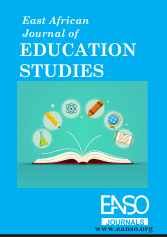Bridging Enrolment Gap: Exploring Obstacles and Strategies to Improve Inclusivity for Students with Disabilities in Kenya's Private Higher Education. Literature Review
Abstract
Despite the presence of policies supporting the inclusion of persons with disabilities in Kenyan learning institutions, including the Sector Policy for Learners and Trainees with Disabilities (2018), the Kenyan Constitution (2010), the Disability Act (2003), Ominde Report (1964) among others and Kenya's status as a signatory to international conventions; the enrollment of students with disabilities in private higher education institutions in Kenya remains low hindering their inclusivity. In spite of the efforts to attain inclusive education, it is still estimated that 258 million children, adolescents and young people do not enter the school system which represents 17% of the world’s population. Specifically, in higher education the percentage is even higher, reaching approximately 60% of people who do not enter that educational level. Therefore, the gross average world enrollment rate reached only 38% in 2018. Furthermore, wide differences were observed between low-income countries with a 9% enrollment, as compared to high-income countries, where 75% was attained. According to the Commission of University Education Statistics 2017-2018, the reported number of students with disabilities in Public and Private Universities reduced by 10% from 881 in 2016 to 793 in 2017. Most of these learners were admitted to government Universities (681) representing 85.9% of the total admitted in comparison to Private Universities (112) representing 14.1%. This article explores the factors contributing to this low enrollment gap hindering inclusivity and proposes strategies to improve the implementation of inclusive policies. Through an extensive literature review, the article identified barriers hindering the effective implementation of inclusive education policies. By emphasizing the importance of adhering to these laws, the study sought to provide insights that can inspire private universities to take decisive actions to improve inclusive education, thus boosting the enrollment and academic success of learners with disabilities in private universities in Kenya
Downloads
References
Abuya, E. O. &Githinji, J.W. (2021) Access to University Education by Learners with Physical Disabilities: Combating the Barriers Buffalo Human Rights law review vol. 27 issue 1 https://digitalcommons.law.buffalo.edu/bhrlr/vol27/iss1/1
Committee on Persons with Disabilities 2006: United Nations. (2006). Convention on the rights of persons with disabilities. United Nations.
Dua v.& Dua A. (2017) Inclusive Education: Challenges And Barriers. Indian Journal Of Research Vol 6 issue 1
Gulzar, A. A. (2021) Challenges and Barriers to Inclusive Education.https://educarepk.com/challenges-and-barriers-to-inclusive-education.html
Fitri, H. (2023) What can universities do to attract and support students with disabilities?
Jean-Joseph L. (2020) Improving Educational Experiences of Students With Disabilities at a Private Postsecondary University Abraham S. Fischler College of Education Nova Southeastern University
Karanja N. D., Kamere M. I.&wawire, V. (20210Inclusive Education Policy and Its Influence on Academic Participation of Students with Disabilities in Selected Public Universities in Kenya International Journal of Multicultural and Multireligious Understanding vol 8, no 11
Kenyan Constitution 2010: Republic of Kenya. (2010). Constitution of Kenya, 2010. Government Printer.
Kochung E. J. (2011) Role of Higher Education in Promoting Inclusive Education: Kenyan Perspective. Journal of Emerging Trends in Educational Research and Policy Studies VOL2 ISSUE 3:144-149
Masoga, M. A., & Maoto, S. K. (2021). Inclusive education in sub-Saharan Africa: Trends, challenges, and prospects. Journal of Inclusive Education, 15(2), 123- 135. https://doi.org/10.xxxx/xxxx
Mapurisa, R.D. (2018) Policy brief inclusive tertiary education for youths with disabilities. Retrieved from the webhttps://safrap.wordpress.com/wp-content/uploads/2018/12/inclusive-tertiary-education-for-youths-with-disabilities.pdf
Morley, L. &Croft, A.2011Agency and Advocacy: disabled students in higher education in Ghana and Tanzania Research in Comparative and International Education Volume 6 Number 4 www.wwwords.uk/RCIE
Mphohoni M.R., Geiger M., Visagie S., Manafe M. (2024) Staff perception on including students with physical disabilities at a South African university. African Journal of Disability. Doi: 10.4102/ajod.v13i0.1347. PMID: 38628959; PMCID: PMC11019107.
Mwale, E. G. C. (2023) An investigation into the challenges of inclusive education in institutions of higher education in Malawi. UNICAF University
National Disability Main Streaming Strategy (2018-2022) Government of Kenya.
Ngui, T.K. (2019) Inclusive Education in Higher Education Institutions in Kenya Journal of Education and Practice Vol.10, No.3, 201P Pages 41-53
Ominde, A. (1964). The Report of the Commission on Education and Training in Kenya (Ominide Report). Government Printer.
Salamanca World Conference 1994: UNESCO. (1994). The Salamanca statement and framework for action on special needs education. World Conference on Special Needs Education: Access and Quality. UNESCO.
Siieikii, R. A. (2010) Institutional provisions and practices facilitating disability inclusion: a case study of the University of Nairobi." Master of Arts, University of Nairobi.
Republic of Kenya, Ministry of Education, Sector Policy for Learners and Trainees with Disabilities. (2018). https://planipolis.iiep.unesco.org/sites/default/files/ressources/kenya_sector_policy_learners_trainees_disabilities.pdf
SDG-Education 2030 Steering Committee (2020). Making Higher Education More Inclusive.
UNDRR (2023) Global survey on persons with disabilities and Disasters Retrieved from the web 25/7/2024https://www.undrr.org/report/2023-gobal-survey-report-on-persons-with-disabilities-and-disasters
UNESCO, 2022, Higher education global data report (Summary). A contribution to the World Higher Education Conference 18-20 May 2022. © UNESCO 2022
UNESCO. (2021b). Global Education Monitoring Report 2021/2: Non-state actors in education: Who chooses? Who loses? UNESCO
UNESCO. (2022a). Right to higher education: Unpacking the international normative framework in light of current trends and challenges. UNESCO.
United Nations CRPD/C/GC/4 Convention on the Rights of Persons with Disabilities. Committee on the Rights of Persons with Disabilities General comment No. 4 (2016) Article 24: Right to inclusive education.
United Nations. (1966). International Covenant on Economic, Social and Cultural Rights. United Nations.
Victoriano E.V.&, Villarreal, E.T(2022) University access policies for persons with disabilities: Lessons from two Chilean universities, International Journal of Educational Development, Volume 91, 102577. Retrieved from https://www.sciencedirect.com/science/article/pii/S073805932200027X
Williams, J., & Usher, A. (2022). 2022 World Higher Education: Institutions, students and funding. Higher Education Strategy Associates.
Copyright (c) 2024 Annerose Wanjiku Wang’ang’a, PhD

This work is licensed under a Creative Commons Attribution 4.0 International License.




























